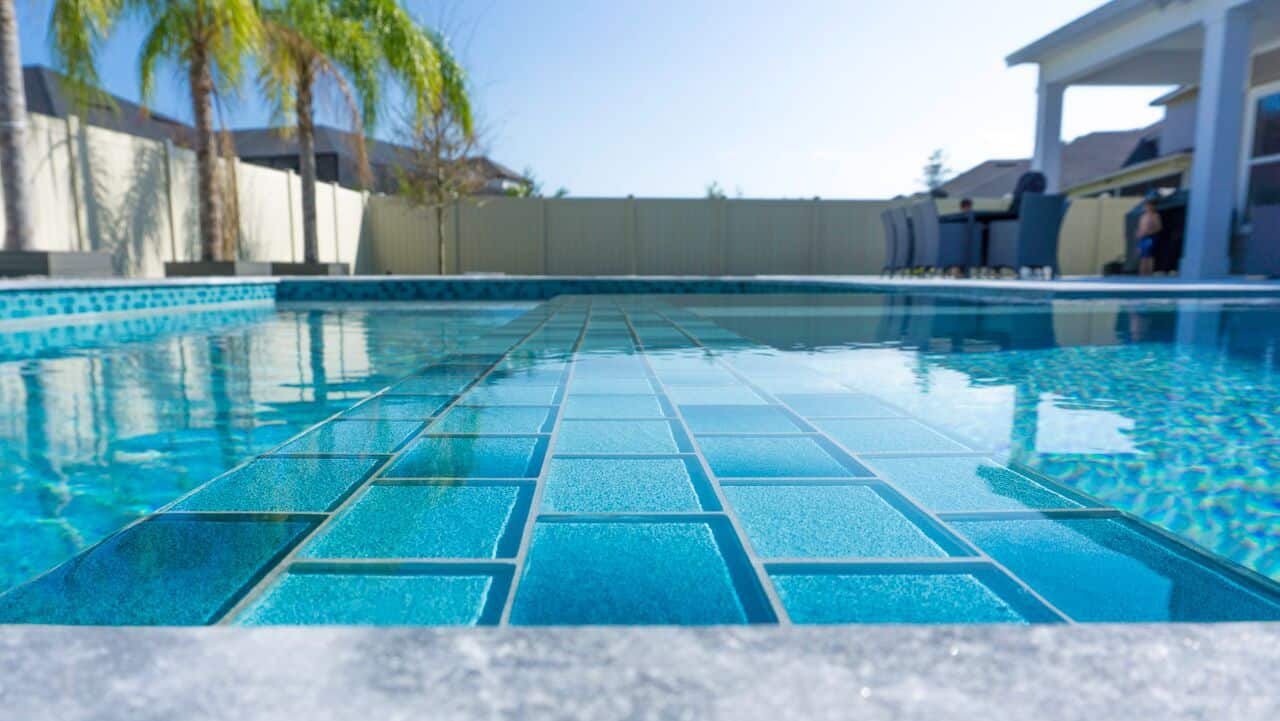Calcium Buildup and How to Remove It

As we delight in the most wonderful time of the year and prepare to enjoy time with our loved ones, it’s important to make sure our homes are comfortable and ready guests. Pool owners are especially blessed to have an optimal gathering place to build family bonds and create unforgettable memories. As you prepare your pool area for guests, you’ll want to make sure your pool is sparkling clean and as bright as the lights around your tree. Getting rid of calcium scaling is imperative to enjoying a bright and beautiful pool.
What Causes Calcium Scaling?
When you first decided to build a pool, the luxury design you imagined was likely a beautiful oasis, glistening all year round. Chances are, you weren’t picturing the unsightly presence of calcium stains on your pool walls. Calcium scaling pollutes your pool and stains the walls with unattractive, chalk-white deposits along the water line. This occurs because of calcium hardness levels in the water and pH imbalances. Heat raises water temperature and causes rapid evaporation. The perfect calcium hardness level is between 200 to 275 ppm, but certain areas have naturally high levels of calcium, making managing calcium hardness a challenge for pool owners. It’s difficult to keep it controlled, but with proper maintenance and chemical balancing, it’s possible. Scales and stains can be removed, and preemptive steps can be taken to keep them from re-forming. If your pool has an accumulation of calcium scaling already, it’s especially important that you understand what is required to tackle this unpleasant problem and prevent it from recurring.
Keeping Calcium Controlled
Calcium hardness has a direct correlation with the chemical balance in your pool. Here are a few systems for handling it: keep your pool water balanced chemically, it’s the most important step in regulating calcium scaling. The pH and alkaline levels are the most significant factors when dealing with this problem, and keeping chemical levels in the ideal range is vital. Testing and balancing your water’s chemicals weekly will allow you to make the necessary adjustments in calcium.
Understanding Calcium Scaling
The two kinds of calcium scales that accrue in pools are calcium carbonate and calcium silicate. The easiest one to remove is calcium carbonate, which is a white, flaky deposit. Calcium carbonate scaling forms along the pool’s waterline as evaporation rises. Calcium silicate, on the other hand, is a white-grey color and is more difficult to remove. Its accumulation could indicate scaling in pool pipes as well. We suggest a pool specialist eliminate these deposits in your pool and filter system. You can assess the type of calcium you have in your pool by placing a couple drops of muriatic acid on a deposit. If it reacts with the acid and foam, it’s calcium carbonate. If it doesn’t react, it’s calcium silicate.
Ways to Remove Calcium Scaling
You can get rid of calcium carbonate deposits with a pumice stone, a stain eraser or a scale remover. A pumice stone and the surface being cleaned must be kept wet to prevent scratching and should only be used on hard surfaces like tile and concrete. Stain erasers will also remove calcium carbonate and can be applied to certain areas with a cleaning pole. Pool supply stores sell calcium scaling treatments, which are added to the pool water. Removing calcium silicate scaling is much more difficult and can usually only be accomplished with a pumice stone and strenuous work. A pumice stone can’t be used on fiberglass pools because it will scratch the surface.
Calcium Scale Prevention
There are numerous ways to prevent calcium scaling in the future to keep your pool clean and gorgeous. The pH levels in your pool are extremely important and have a huge effect on calcium scaling. Lowering the pH levels in your pool water can help prevent calcium buildup. Prevent calcium accumulation by regularly monitoring and balancing your pool’s chemicals. You can also use a sequestering agent to keep calcium locked up in a solution, so it doesn’t turn into scaly deposits. This only occurs without regular maintenance.
Attacking Calcium Buildup
Other measures to prevent and terminate calcium scaling are:
Avoid calcium hypochlorite shock, which adds calcium to the pool. Use a non-chlorine oxidizer instead.
Use a clarifier to seek out calcium elements and cluster them together so the pool filter can remove them.
Brush, vacuum and clean your pool regularly to dispose of newly-formed scale, calcium dust and dirt.
Try the pool draining method, which is the best way to permanently lower your calcium hardness level. It requires a lot of work and involves draining about one-fourth of your pool water and then testing it again.
Purposely cloud the pool water and use flocculant. If you want the calcium gone rapidly, this is a great technique. You intentionally raise the pH and alkalinity levels, which clouds the water, then use a flocculant to force all the white calcium into a cloud on the pool floor. Quickly vacuum and remove.
The holidays are a magical time of year, but in the midst of planning, things can get a little hectic. As you spend precious time with family and friends, make sure your favorite gathering place glitters just as brightly as the rest of your home. Calcium scaling will diminish the elegance and beauty of your pool. Take steps to prevent scaling, so you can relax and enjoy the tranquility and serenity of your luxury pool.
